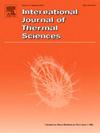A numerical study of blockage and inclination effects on natural convection in a uniformly heated air flow channel
IF 4.9
2区 工程技术
Q1 ENGINEERING, MECHANICAL
International Journal of Thermal Sciences
Pub Date : 2025-02-13
DOI:10.1016/j.ijthermalsci.2025.109783
引用次数: 0
Abstract
The present study is concerned with the flow behaviour and thermal performance of an air flow channel subject to uniform heating with an adiabatic circular cylinder symmetrically positioned in the channel. A two-dimensional numerical study is conducted, covering a range of blockage ratios (, the ratio between the cylinder diameter to the channel width), inclination angles (, relative to horizontal plane), cylinder positions (, the distance from the inlet), and Rayleigh numbers (, up to 6.0 × 1011). It is observed that vortices shed from the cylinder interact with the thermal boundary layers (TBLs) adjacent to channel walls, which disturbs downstream TBLs and enhances mixing in the channel. For = 6.0 × 1011, the averaged lateral wall temperature of a vertical channel ( = 90°) drops by 31 % at = 0.50, and the mass flow rate through the channel increases by 40 % at = 0.25 compared to an unblocked vertical channel (i.e., without the cylinder). In a channel inclined at = 30°, up to 29 % reduction of the averaged wall temperature is achieved compared to an unblocked inclined channel at = 6.0 × 1011. However, the inclination of the channel from the vertical position generally deteriorates its thermal performance. Moreover, at = 0.75 and = 6.0 × 1011, the flow skews towards one lateral wall at = 30° and 90°, resulting in an irregular wake, but the flow structures are more symmetric at = 60°. The results reported here provide a passive strategy to design obstacles in convective flow channels for optimising thermal performance.
求助全文
约1分钟内获得全文
求助全文
来源期刊

International Journal of Thermal Sciences
工程技术-工程:机械
CiteScore
8.10
自引率
11.10%
发文量
531
审稿时长
55 days
期刊介绍:
The International Journal of Thermal Sciences is a journal devoted to the publication of fundamental studies on the physics of transfer processes in general, with an emphasis on thermal aspects and also applied research on various processes, energy systems and the environment. Articles are published in English and French, and are subject to peer review.
The fundamental subjects considered within the scope of the journal are:
* Heat and relevant mass transfer at all scales (nano, micro and macro) and in all types of material (heterogeneous, composites, biological,...) and fluid flow
* Forced, natural or mixed convection in reactive or non-reactive media
* Single or multi–phase fluid flow with or without phase change
* Near–and far–field radiative heat transfer
* Combined modes of heat transfer in complex systems (for example, plasmas, biological, geological,...)
* Multiscale modelling
The applied research topics include:
* Heat exchangers, heat pipes, cooling processes
* Transport phenomena taking place in industrial processes (chemical, food and agricultural, metallurgical, space and aeronautical, automobile industries)
* Nano–and micro–technology for energy, space, biosystems and devices
* Heat transport analysis in advanced systems
* Impact of energy–related processes on environment, and emerging energy systems
The study of thermophysical properties of materials and fluids, thermal measurement techniques, inverse methods, and the developments of experimental methods are within the scope of the International Journal of Thermal Sciences which also covers the modelling, and numerical methods applied to thermal transfer.
 求助内容:
求助内容: 应助结果提醒方式:
应助结果提醒方式:


